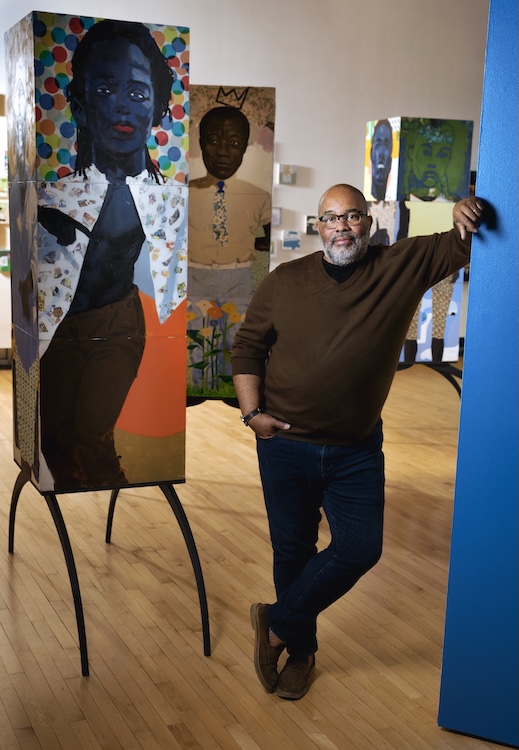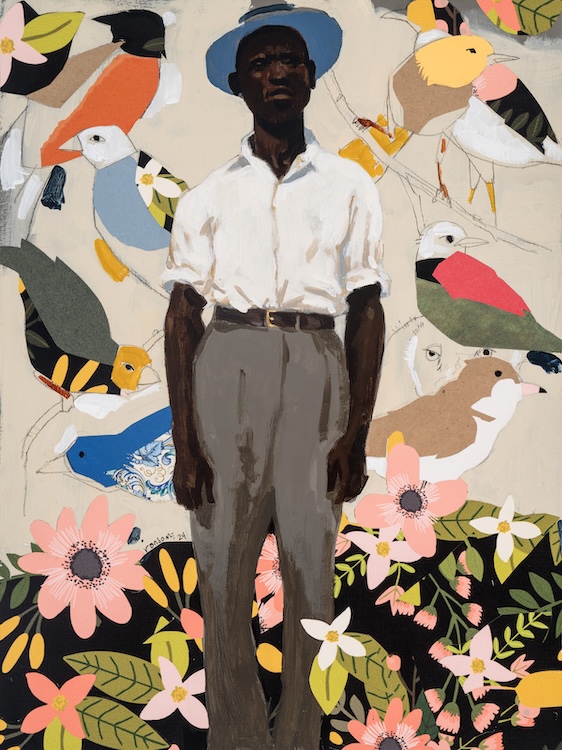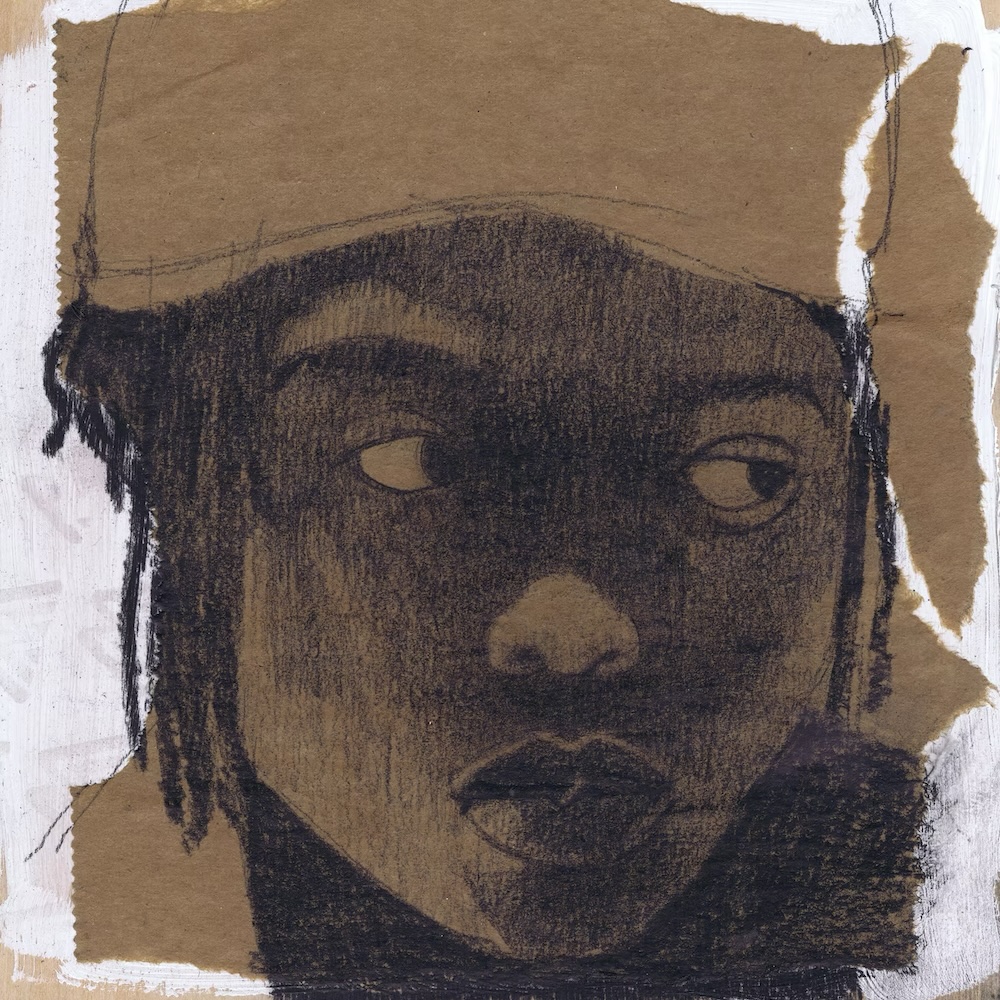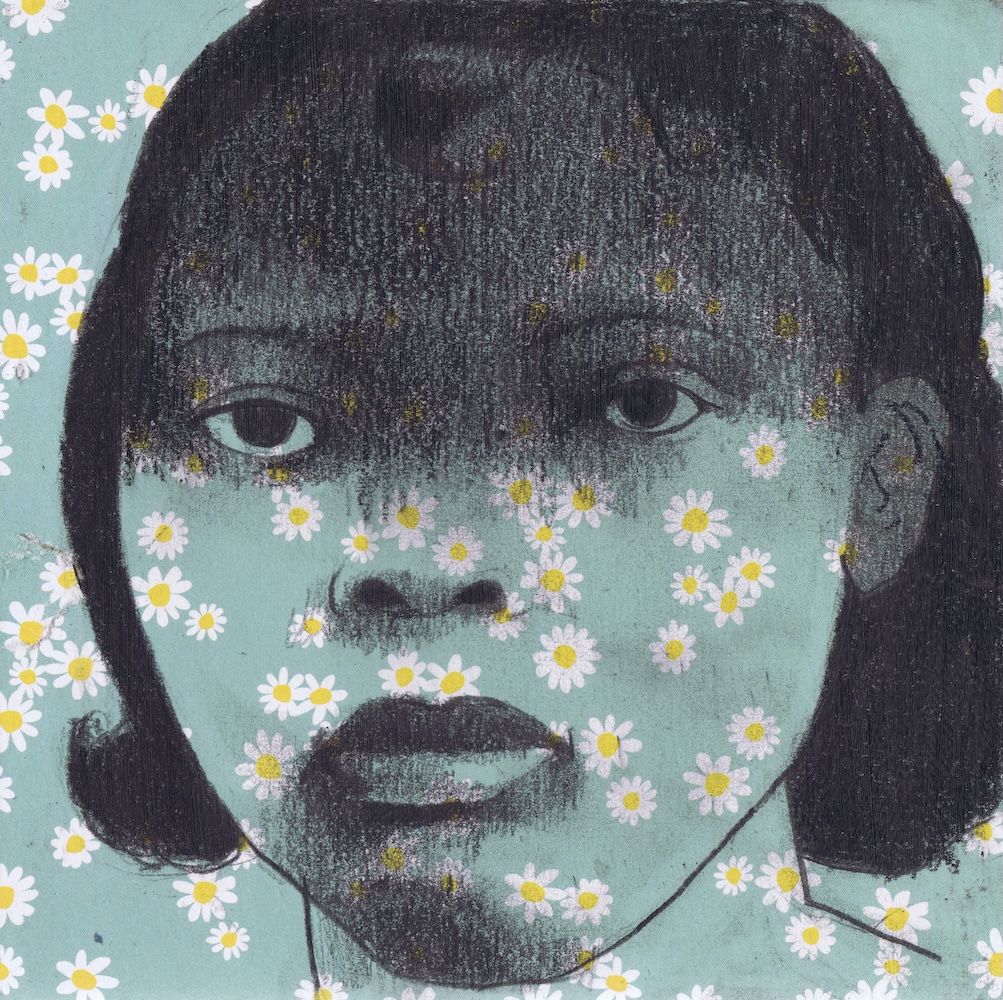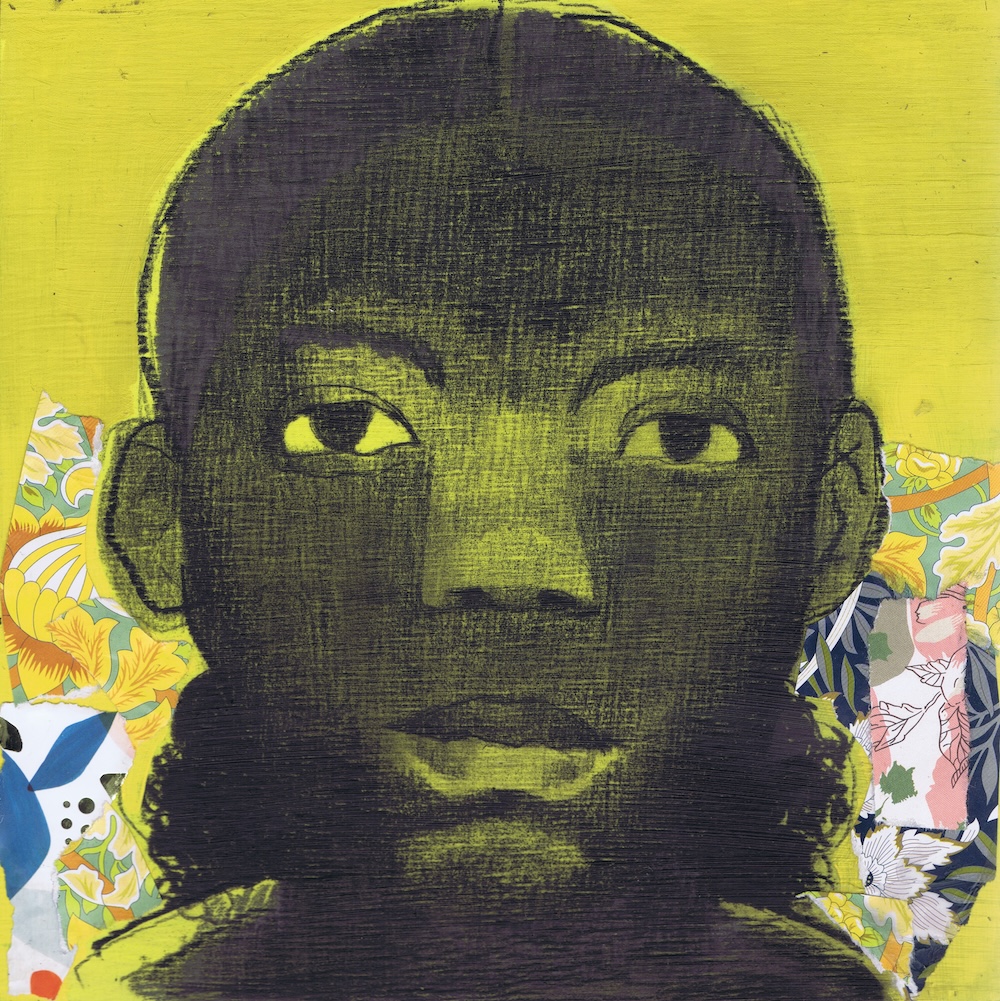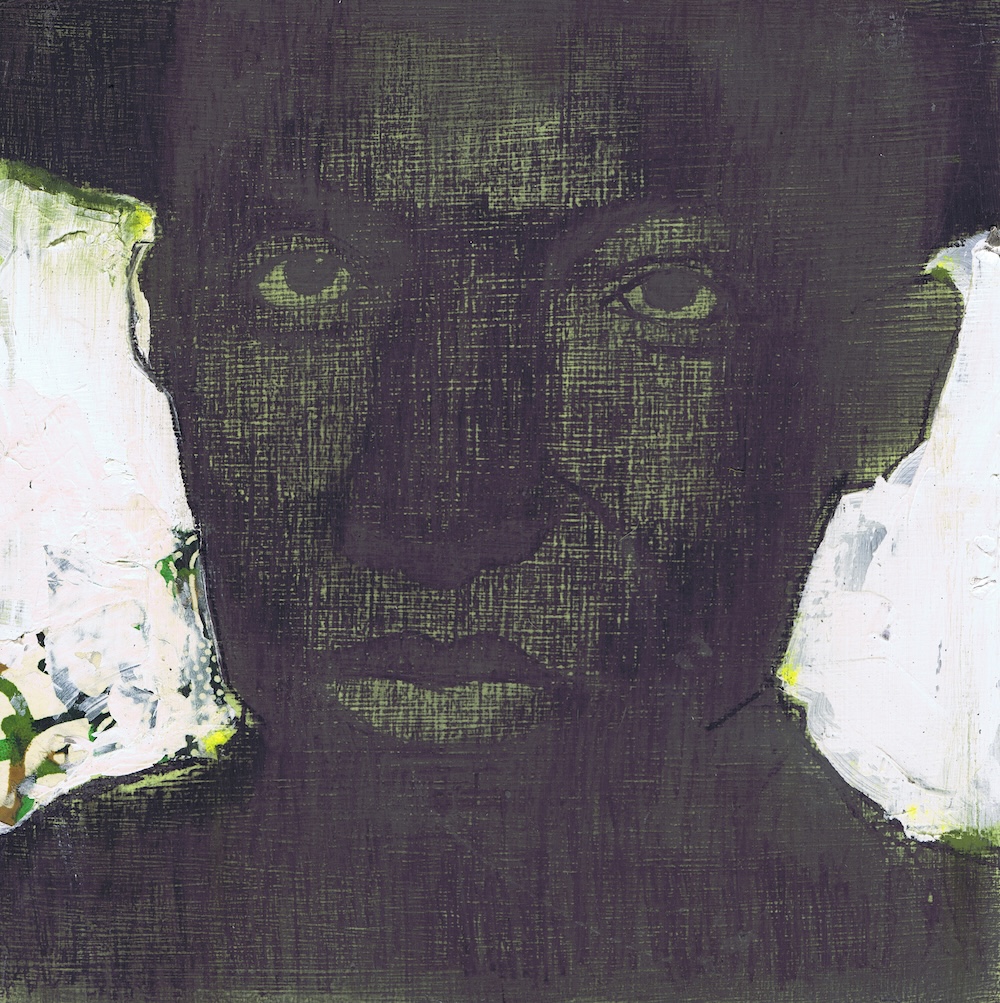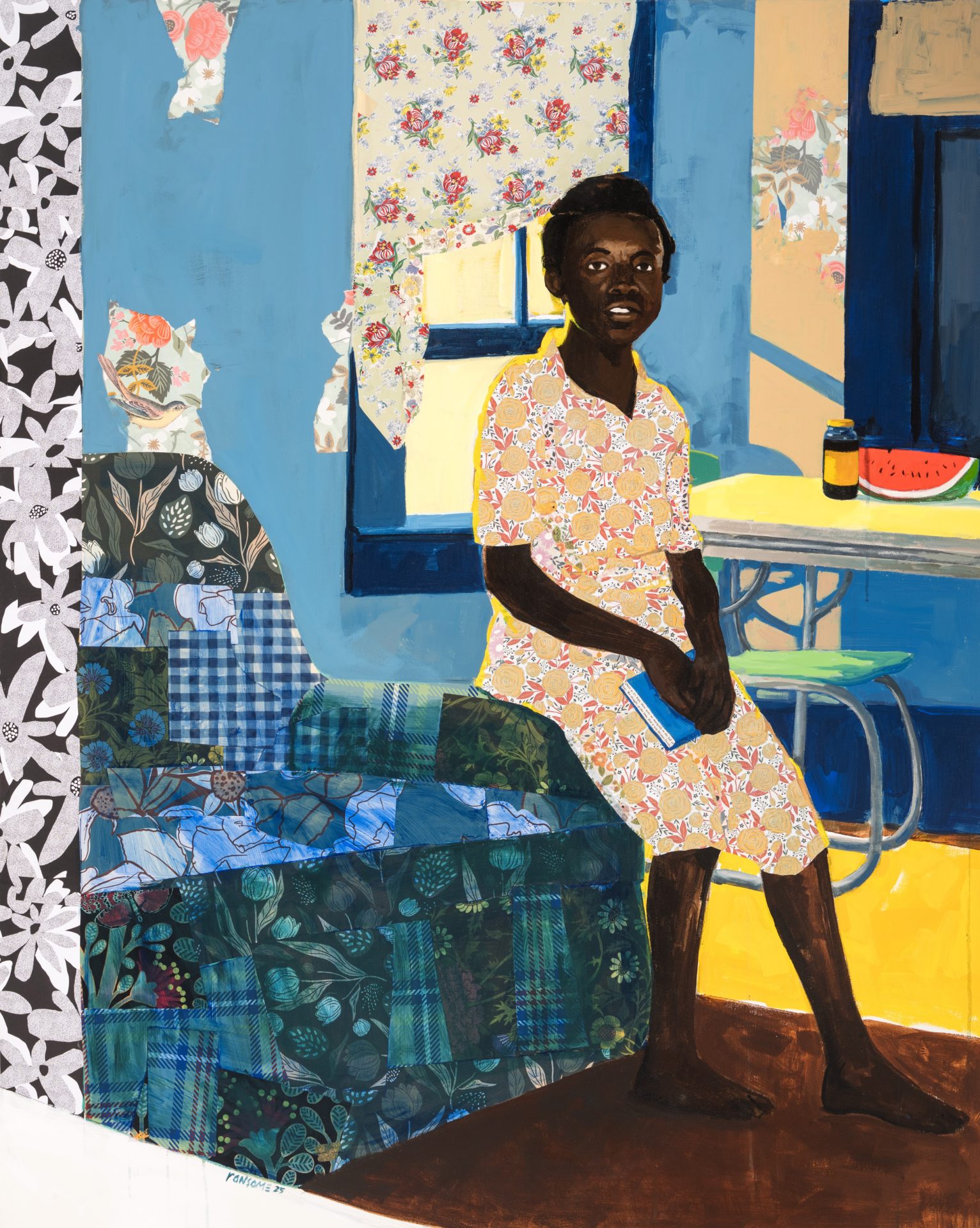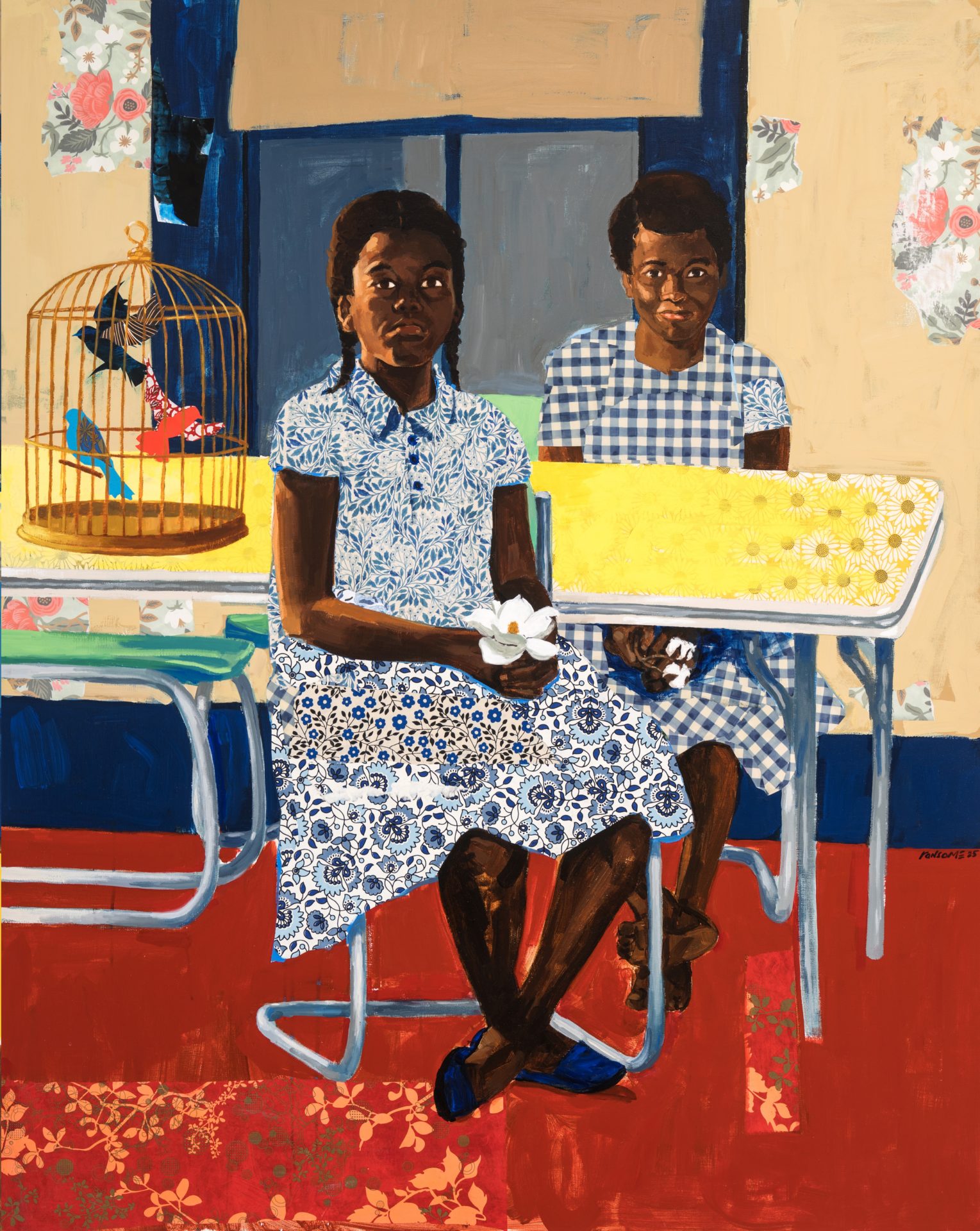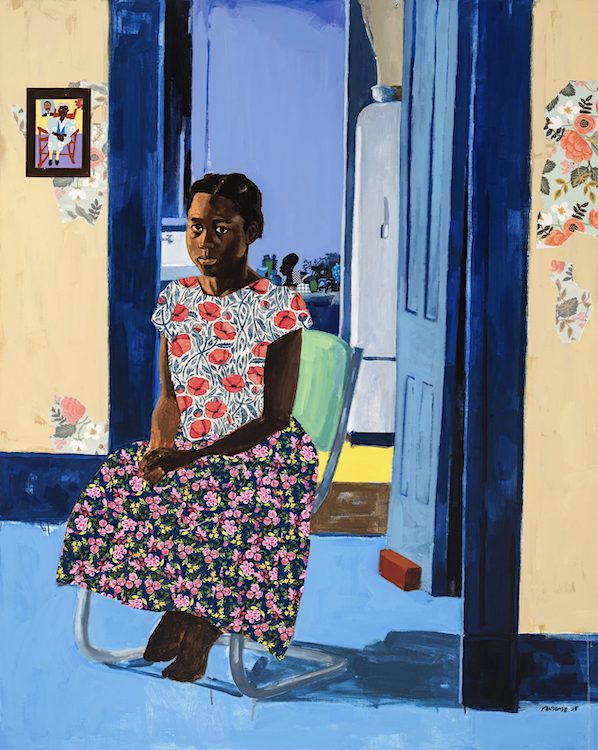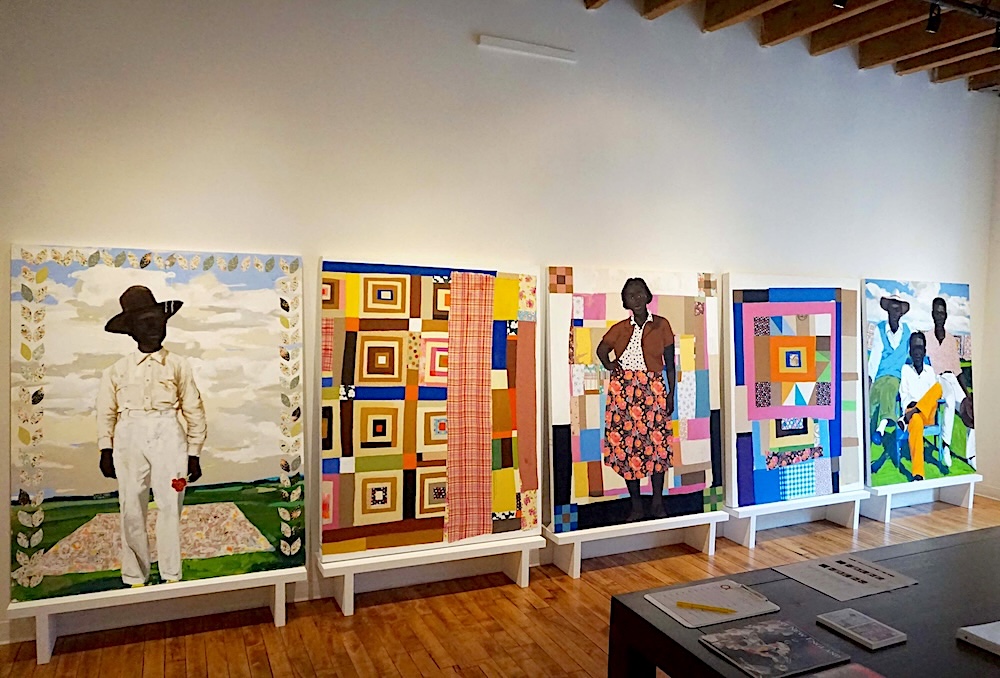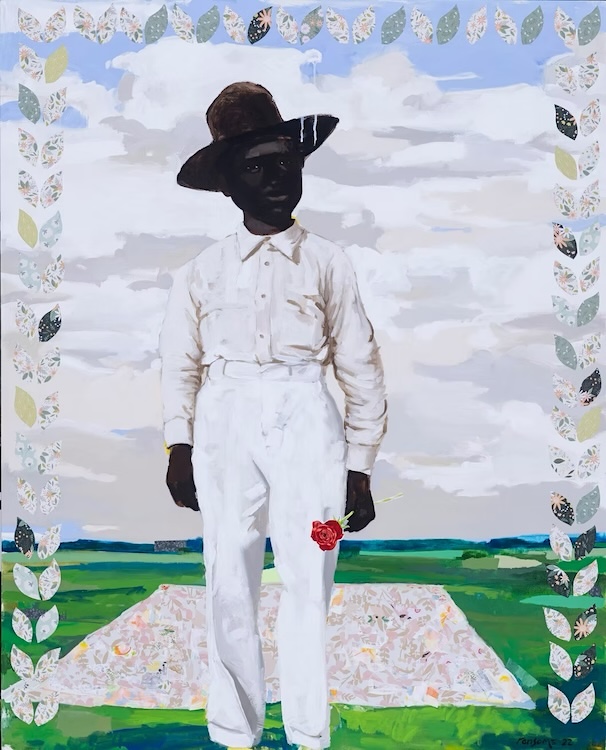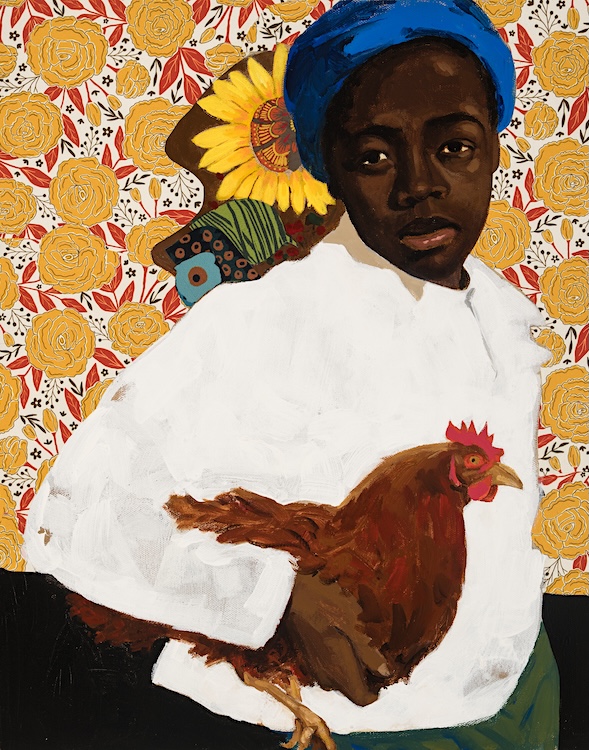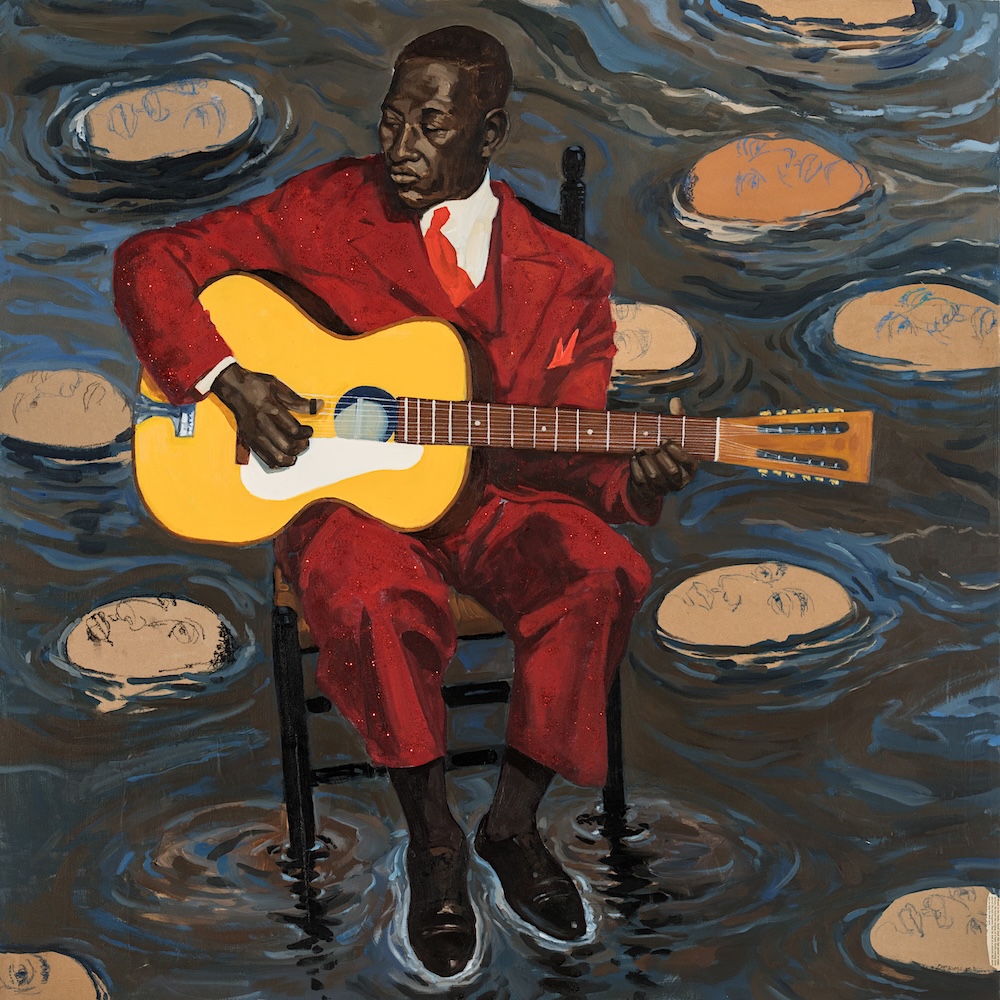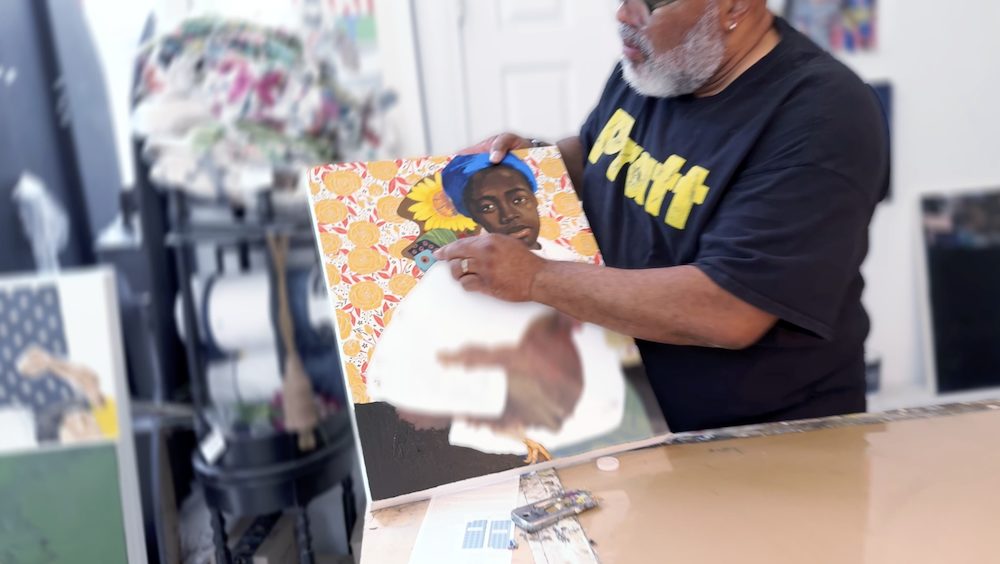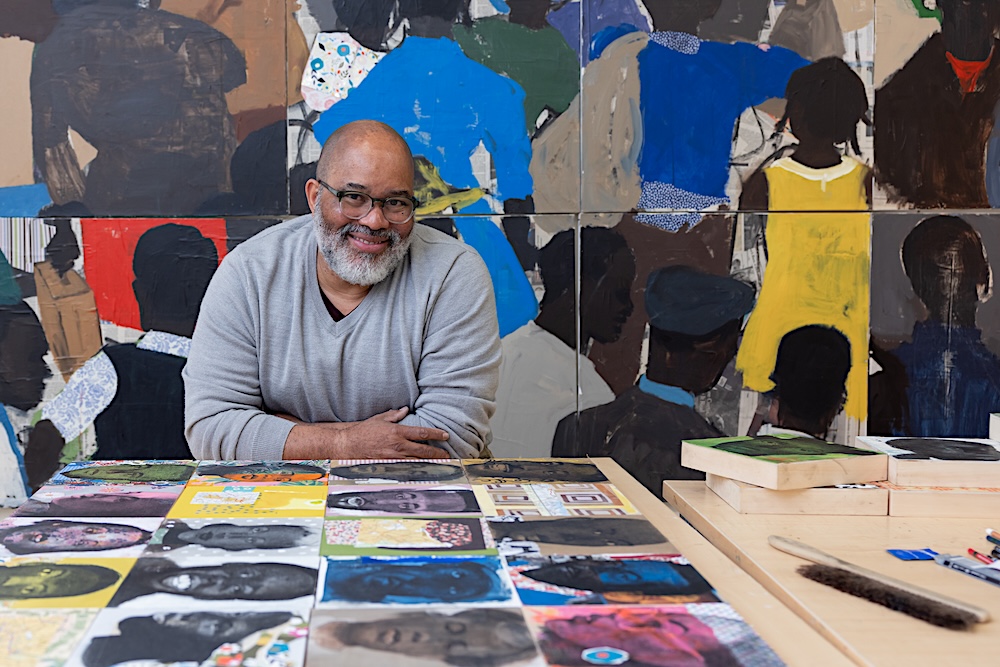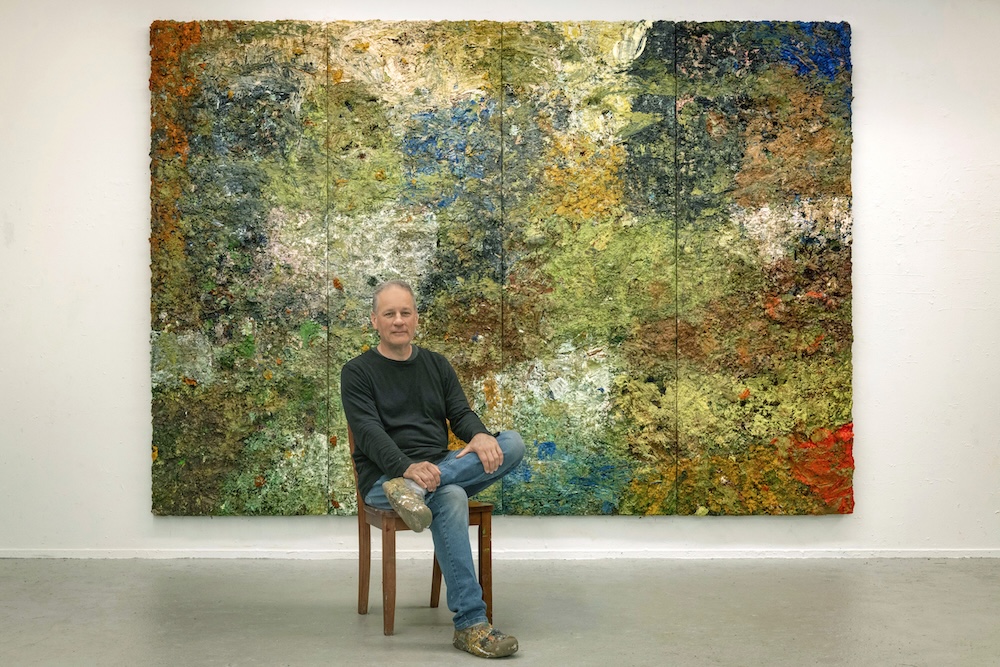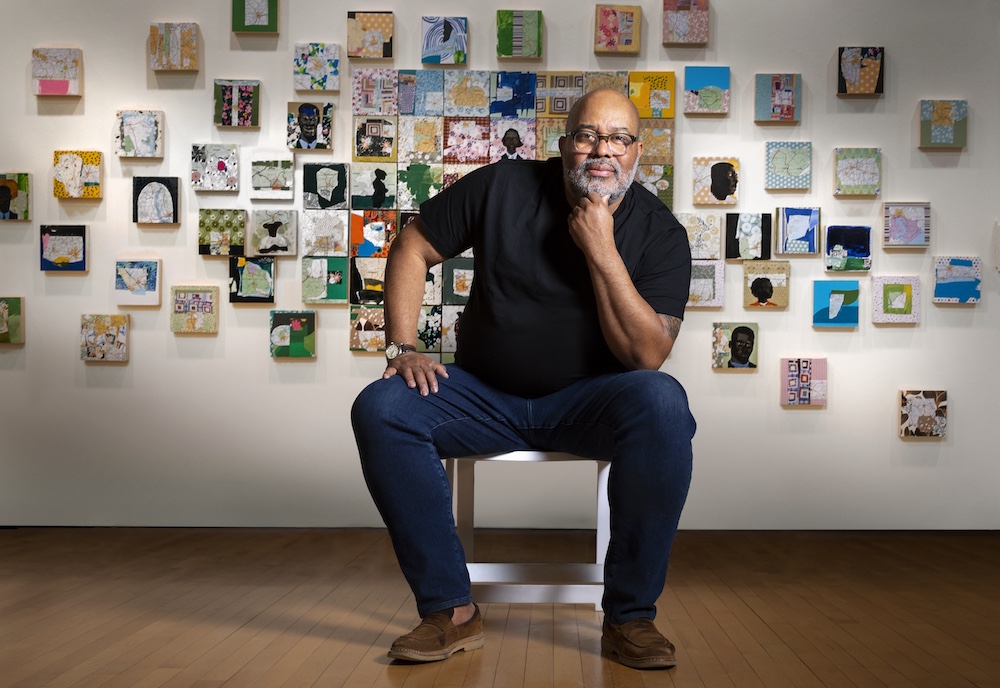
In the Studio with Contemporary Expressionist Ransome
In his upcoming exhibition A House Is Not a Home, Hudson Valley–based artist Ransome continues his lyrical exploration of memory, migration, and belonging. Drawing from his African American lineage, his vibrant mixed-media art is rich in symbolism and story, paying homage to Southern sharecroppers and their descendants who made the journey north during the Great Migration and beyond. While his pictorial narratives are deeply personal, the portraits he portrays, along with his use of quilting patterns, fragments of text, and everyday objects, convey universal themes of belonging and resilience.
As Ransome himself affirms, “The history of my family is the history of Black Americans, which is the history of all of North America.” Through his beautiful work and the collective story he tells, he therefore traces his own family’s history of migration, separation, and resilience. In bold color and layered surfaces, as well as the creation of some three-dimensional oeuvres, he evokes presence and absence, a nostalgia and celebration threaded with complexity and loss. In each, acrylic paint merges with found and made textures and objects, echoing a legacy of resourcefulness—of making something out of nothing– something that holds potency, beauty, alchemy, and resilience.
Ransome’s surfaces carry the pulse of music, borrowing the spontaneity of hip hop creatives who sample and recombine sound, and the soulful traditions of rural quilters who stitch beauty from scraps. Infused with the raw immediacy of Abstract Expressionism and the spiritual resonance of the Gee’s Bend quilts, his collaged images weave between abstraction and representation, layering opposites—paint and paper, busy and quiet, found and chosen. In so doing, he has created a body of work that illuminates how love, community, and tradition are the real “stuff” that make a house into a home–even in the face of displacement and unwelcoming ground.
“The history of my family is the history of Black Americans, which is the history of all of North America.”
Want to know more? Read our Exclusive Interview below. And, if you happen to be in Boston between now and October 18th, 2025, don’t forget to see his vibrant, captivating solo exhibition, A House Is Not a Home, at Alpha Gallery.
The series, and this episode of “In the Studio With…” was produced in collaboration with Richard Hall and Mimi Young, founders of littlebitcreates.
Let’s get to know, Hudson Valley artist, Ransome.
INSIDE+OUT: Where are you originally from, and how did you wind up in the Hudson Valley NY?
Ransome: I am originally from a small town in North Carolina called Rich Square. I lived there with my grandmother, who was afraid to live by herself, especially once the sun set. I stayed there until I was almost sixteen. During that time, I traveled sporadically to New Jersey to spend time with my mother, who, like her older siblings except for one, migrated North. I loved living in the rural South, with its slow pace, fresh air, and space. But I missed my cousin, who seemed to have everything that my small town didn’t. I missed my family, movie theaters, and access to so many things. So, I moved to Bergenfield, New Jersey, with my mother months before I turned sixteen. I went to college at the Pratt Institute, where I met my wife, the renowned children’s book author, Lesa Cline-Ransome. After college, she moved to Jersey City, while I moved to my father’s house in Paterson, New Jersey. Once we got married, we got an apartment in Jersey City Heights, which is just across the river from Manhattan. When we went looking to buy a house, we considered places like northern New Jersey, Westchester, and Putnam County, but eventually settled on Dutchess County because it was more affordable. Thus, we found a house in Poughkeepsie NY and were expecting our first child. At that time, my wife was a copywriter for Macy’s with the intention of her commuting to NYC. We liked Poughkeepsie because there was a direct train line going into The City. Once our first daughter, Jaime, was born, Lesa decided to stay home, which in turn sparked her career in writing children’s books. Ten years later, we decided to move to a more rural area here in Rhinebeck NY.
What inspired you to become an artist, and what was your journey?
Ransome: The journey is a very long story. I have always liked to draw, and living in Rich Square, North Carolina, with my grandmother, I had a lot of alone time. I would entertain myself by watching way too much TV with stacks of typewriter paper (which is now computer paper) and surrounded by comic books and MAD Magazines. I would spend endless hours drawing, making comic books about me and my friends. Keep in mind, I was living in an art desert. Art wasn’t taught in any of the schools I attended in North Carolina. I watched TV programs, read magazine articles about anything art/drawing, and checked out books from my school’s library on “how to draw.” When I moved to New Jersey, it was the complete opposite. In my high school, there were at one point eight or nine art teachers. There was an amazing system set in place in the art program. In your freshman year, you took general art classes to see what interested you. Classes like drawing, painting, ceramics, metal-smithing, filmmaking, and photography were offered. Once you took two or three of these core classes, you could then take independent study classes, like graphic design, higher-level photo classes, for example. Other classes were offered if there was enough interest. We went off campus to draw from the model at a local art center. I fell in love with filmmaking, despite only taking one painting class. The majority of my high school career was centered around photography and filmmaking. We took field trips to NYC once a year to take photos. We had a dark room fully stocked with eight or more enlargers. It was an amazing experience – kind of like getting a taste of your first year at college. Most of my teachers went to Pratt and borrowed their teaching systems, which piqued my interest. Once I saw the small, beautiful campus in the middle of an urban neighborhood, I knew that it was the place for me.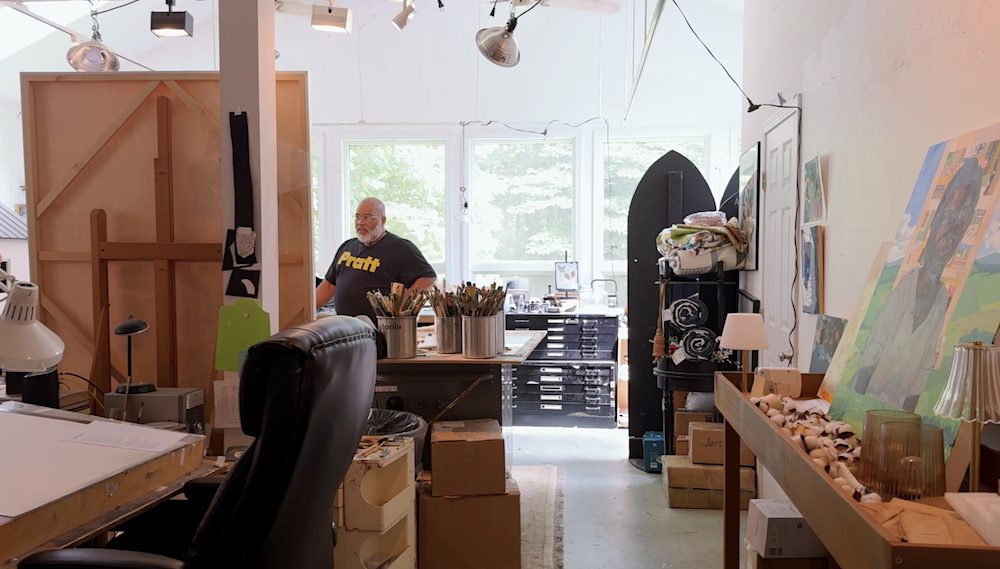
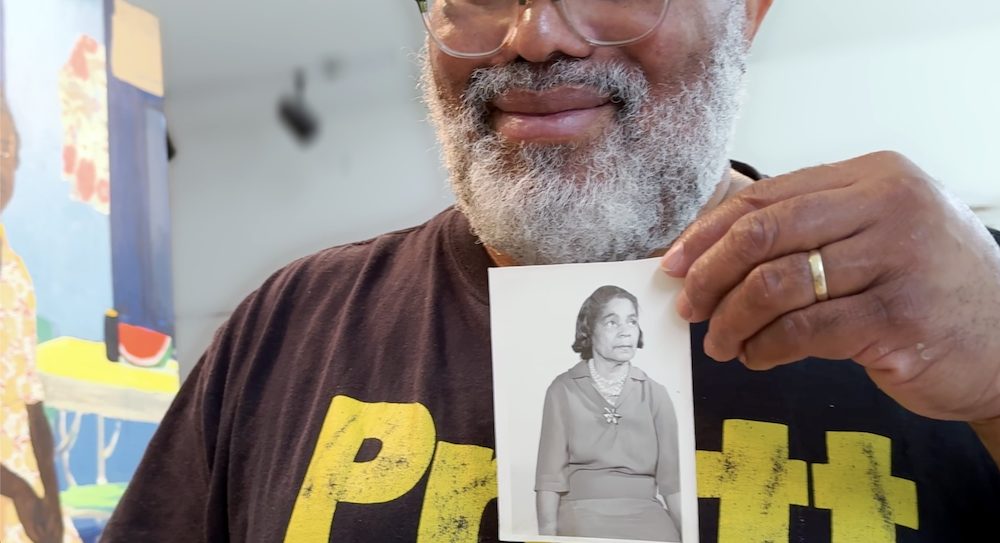
Your grandparents play a role in your work. Can you share more about them?
Ransome: My work starts with my grandmother, who was born in 1899. She and my grandfather, Tommy, had ten children. Together, they raised all of the children in Northampton County, North Carolina, during “The African-American Great Migration” (1910s-1970s). Eventually, they all migrated north except for one child who stayed and married a farmer and lived her life in North Carolina. I never met my grandfather as he died when my mother was a child.
What else inspires your artwork? Tell us about your creative process.
Ransome: It wasn’t until I was in grad school, which was just four years ago, that I started thinking about developing my practice around my family and The Great Migration. You may have noticed that the word “migration” has come up a few times in this interview. In grad school, I was searching for a reason to make artwork, so I started to look at my family. The Great Migration was something I participated in. It started in 1917 and ran through the late 70s. I moved in 1977. This important movement has been a consistent thread in the fabric of my life.
My process is long and short, quick and slow. The seed was planted in 1899 in North Carolina, with its roots spreading in The South, and the trunk grew upward, with 6 million black Americans moving north to concrete cities. The branches grew out with the children of migrants living in northern cities. Then those heavy, long branches bend downward with the grandchildren of migrants returning to The “New” South. So, it’s a full circle.
You have a show this month. When and where? Tell us about the work you’re exhibiting in this show.
Ransome: The title of the exhibit is A House Is Not a Home and is on exhibit at Alpha Gallery in Boston, MA. Here is my artist statement:
“A chair is still a chair,
Even when there’s no one sittin’ there.
But a chair is not a house,
And a house is not a home,
When there’s no one there to hold you tight,
And no one there you can kiss goodnight.
A room is still a room,
Even when there’s nothin’ there but gloom.
But a room is not a house,
And a house is not a home,
When the two of us are far apart.”
“A House Is Not a Home” is an R&B song that gained popularity when it was sung by the late R&B singer Luther Vandross in 1981. The song reminds us that an object or a house does not make it a home. The love that folks bring to a house is what makes it a home.
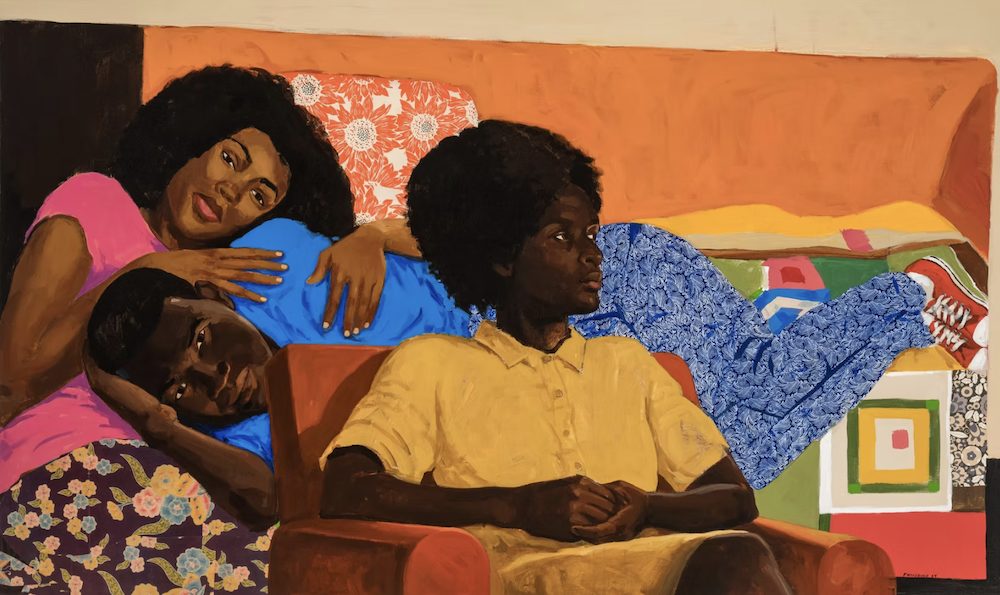
In my third solo exhibit at the Alpha Gallery, A House Is Not a Home explores the love and community and customs black Americans had in The South while surrounded by a hostile, racist, and Jim Crow unwelcoming environment. That love traveled with them to all the places they relocated to outside of The South during the fifty-six-year Great Migration. These works grapple with the African-American search for belonging and call into question the sincerity of homes forged in unsafe and unwelcoming conditions. And how the celebration of home is built on the structure of love and community.
What makes living in the Hudson Valley special for you?
Ransome: Remember, I am the guy who loves The South, and its space and quiet, but I want access to NYC, culture (museums and galleries), and all the opportunities a metropolitan city offers. Living in the Hudson Valley gives me everything. And after living in the valley for 30 years, I’m just starting to appreciate the Hessel Museum at Bard and the Frances Lehman Loeb Art Center at Vassar College, and both have women in prominent positions.
What are the most challenging and the most rewarding aspects of being an artist?
Ransome: Creating works (art and installations) that inspire conversation, along with meeting so many wonderful people and artists.
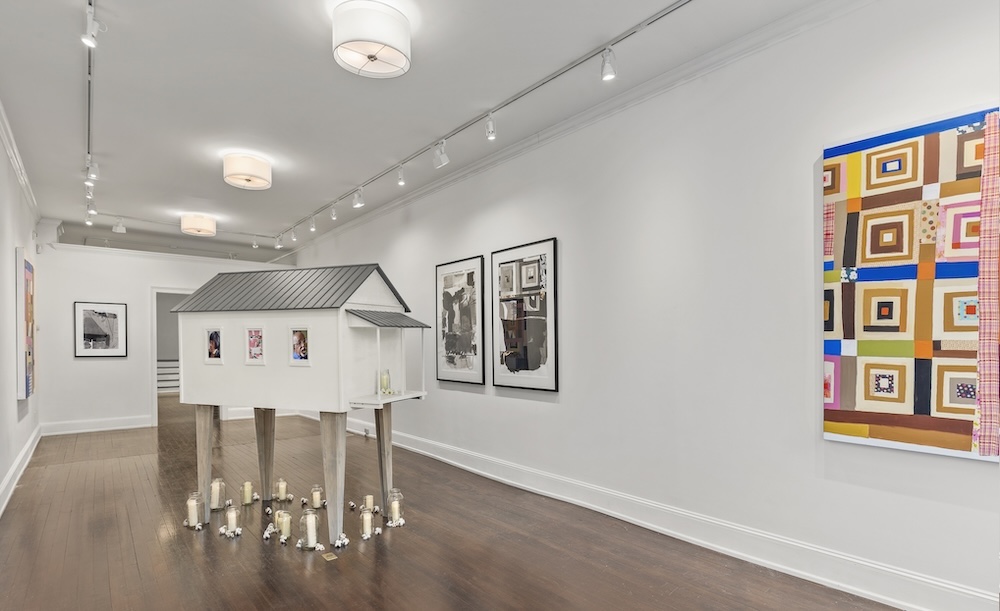
What is one question you’re constantly asked, or the biggest misconception about your work?
Ransome: I am always asked, “Who are the people in your paintings?” I rarely paint people I know in my works. The figures come from books, internet searches, and other places. I prefer to paint people I don’t know because I don’t enjoy feeling the pressure of capturing a portrait, and I am trying to make statements, not paint portraits. You’ll see in future works that I’m moving away from easel painting.
What impact does your artwork have on your community?
Ransome: My work is well-received, but we’ll have to see about the impact in the future.
What local businesses do you rely on to be successful?
Ransome: Well, I believe in community, and I try to bring in as many folks as I can to be a part of the practice. Rhinebeck Artist Shop, of course. Mirbeau is my hideout for quiet lunches—great food with curators and gallery folks. Terrapin is my place for picking up dinner when I’m painting endlessly for an exhibit—their Soul Food Plate brings back memories of The South. Old Mill Wine & Spirits for wine and champagne.
Local Love: What local business should we know about?
Ransome: Well, I have shared many of the places that I enjoy above. I would suggest going to the movies more often—Upstate Films is wonderful. My wife and I went a few weeks back. Also, go out to dinner at one of Rhinebeck’s many wonderful restaurants; you can’t go wrong, and don’t forget Kips Tavern in Rhinecliff, it’s really good and cozy.
What is missing in the area that you wish we had?
Ransome: Maybe a contemporary art gallery, but that’s probably a very selfish wish. More affordable housing would be a better answer.
Who or what inspires you personally?
Ransome: Artists and all types of creators. I have a long list of favorite artists, and Leonardo Drew tops my list. Followed by Kerry James Marshall and Henry Taylor. But some of the folks I call friends also make my long list of artists: Deborah Roberts, Derek Fordjour, and Philemona Williamson.
Tell us something about yourself that people would be surprised to know.
Ransome: I like romantic comedies.
What do you do for fun? What are some of your favorite ways to unwind and unplug when you are not in the studio?
Ransome: Dinner with my wife and or friends and family. Believe it or not, gallery-hopping in The City, playing chess mostly on my phone (I’m not that good, and I am not willing to invest the time to get better). One of my favorite things is being home or traveling with our children. We have four. Jaime is an art curator here in the Hudson Valley, Maya is a creative director at Estee Lauder, Malcolm is an emerging artist/product designer, and Leila works as an administrator at an elementary school in Queens.
If you could have one superpower, what would it be?
Ransome: Well, I’m not a big superpower person—I love Batman because he doesn’t have a superpower! If I had to pick a power, it would have something to do with going back in time. My mother passed away in June, and I miss my father and both my in-laws.
What is your current state of mind?
Ransome: Positive and excited, I have some new ideas about my art practice and some interesting exhibits in the future.
Photos Courtesy of Ransome by John Halpern
Follow/Connect with Ransome via Website | Instagram
+ + +
See more of our IN THE STUDIO WITH… Artist Series:
In the Studio with Artist Elizabeth Keithline
In the Studio with Bespoke Ceramicist R.A. Pesce
In the Studio with Experiential Artist Amanda Russo Rubman
In the Studio with Multimedia Artist David McIntyre
In the Studio With Artist Olaf Breuning: Laughter in the Dark
In the Studio with Contemporary Artist Andrew Lyght
In the Studio with Mixed Media Artist Yoko Izu
In the Studio with Abstract Artist Joel Longenecker
In the Studio with Horticulturist and Encaustic Artist Allyson Levy
In the Studio with Multidimensional Artist David Kucera
+ + +
This ongoing artist series was produced in collaboration with Richard Hall and Mimi Young, founders of littlebitcreates.
Richard Hall and Mimi Young are the creative forces behind littlebitcreates. They produce a variety of projects, including in-depth artist profiles, event-specific promotional videos, and music videos. Their approach is exciting, innovative, and contemporary. In addition to their client work, Hall and Young collaborate with other creatives to create multidimensional, neo-surreal videos as part of a noncommercial venture. Littlebitcreates emerged from the extensive knowledge Hall and Young gained over 30 years of experience in photo shoots and multimedia art. They exclusively shoot all of their videos on iPhones, appreciating the distinctive aesthetic it produces and the comfort it offers their subjects in front of the camera.
Follow + Connect with littlebitcreates via Website | Vimeo | @littlebitcreates
Write a Comment
You must be logged in to post a comment.



